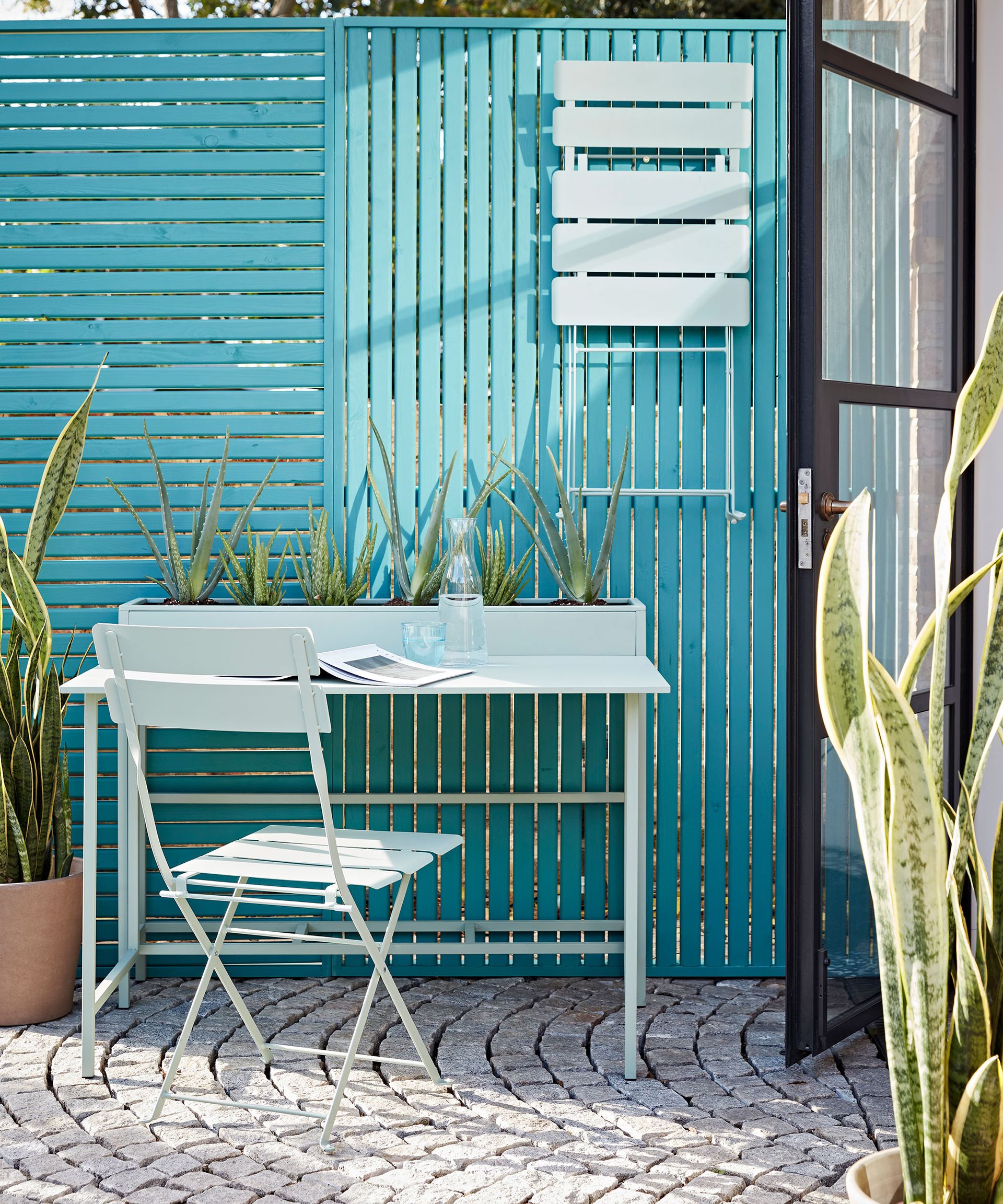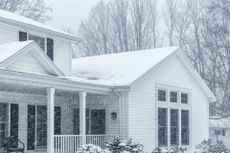Shady garden ideas – 14 modern ways to transform sunless outdoor spots
These shady garden ideas can brighten up even the gloomiest of outdoor spaces by adding color, texture and interest

With summer just around the corner, focus has turned to our outdoor living setups – and rightly so. But if your outside space has more shade than sun, that’s where the best shady garden ideas come in handy. Helping to brighten up sunless spots while adding interest and intrigue, the top shady garden ideas can inject fun and functionality into your outdoors.
But before we delve into the backyard ideas that will help you fall in love with your shade-stricken space once more, let’s get to grips with what is a shade garden? ‘A shade garden is made up of plants that require very low light levels,' says garden expert Tony Woods, from the Garden Club London. 'This is most often because of the aspect of a house being north-facing or being overshadowed by trees of tall buildings.'
But here's the good news. ‘Whilst the assumption is that nothing will grow, by using the right plants a shade garden can be very lush and full of interesting shades and shapes of foliage and small but often sweetly scented flowers,' Tony explains.
So, if you’re living in a built-up urban area, have a small garden or your outside space is north-facing – we’ve compiled a list of expert-approved landscaping ideas to lighten, brighten and rejuvenate your shady spots.
1. Use plants that love shade

You might be fooled into thinking all plants need endless amounts of sun. But in fact this isn’t the case. It's simply a matter of how to choose plants for a garden that are suitable and that will thrive in a shady environment. And according to award-winning garden designer and horticulturist, Tony Woods, from the Garden Club London, ferns of all sizes thrive in shade.
'Tree ferns (Dicksonia antartica) are a favorite for adding height and drama in a shade garden with their impressive fronds and prehistoric-looking trunks,' he says.
'I love to use silver foliage to lighten a shade garden planting scheme including Brunnera ‘Jack Frost’ and Lamium ‘White Nancy’.’
2. Paint the boundaries of your garden a light color

Another point to keep in mind when it comes to gardens covered in shade? Give some serious consideration to the color of your fence. Why? Because along with protecting your plants from the wind and outlining the edge of your outdoor perimeter, garden fencing ideas – whether it’s for big or small gardens – can make a big difference to any outside space.
‘Try painting boundaries a soft, light neutral color to reflect light and provide a fresh backdrop to the space,’ Tony says. ‘Use lots of zesty green foliage or variegated plants especially under trees or in dark corners.’
3. Position your furniture wisely

Instead of going against the grain – work with what you’ve got. And if that’s a shady outdoor space that gets a hit of vitamin D for a couple of hours a day, position your seating in said sunny spot.
That’s what landscape garden designer Kat Aul Cervoni from Staghorndid when creating this urban design, with modern outdoor furniture and colorful accessories with blue tones and yellow highlights.
Kat explains, ‘The furnishings pick up the blues in the pea gravel and bluestone pavers. We used a playful uneven line between the two paving types to add a bit of interest and help distract from the slightly odd asymmetry of the space. Evergreen shrubs give four seasons of interest – a must in any space, but especially in small urban gardens where every bit of green counts.
‘They also help to soften the brick of the neighboring garage and give a nice feeling of enclosure towards the back. A simple plant palette with greens and whites feels fresh all season and lets the colors of the furnishings take center stage. Custom cedar screens hide the unsightly HVAC units.’
4. Create a tranquil shady space

Sometimes, less is so much more. And this modern minimalist urban gardening idea is an example of that.
‘An all-green color palette gives a clean, minimalist feel to this modern space,' Kat says. 'Variegated ornamental grasses help break up the more medium green tones throughout.'
'Evergreen ivy is being trained to climb the walls to soften the concrete and provide color even through the winter. Lounge chairs made of recycled materials in a deep emerald green connect the two groupings of planters for a simple, cohesive feeling.’
5. Add vertical interest

Working with a small shady courtyard? Then instead of thinking about the square footage, it’s time to think vertically. Vertical garden ideas really are the design tricks that keep on giving. By increasing the amount of growing space, and helping to spruce up any unused corners, you can cheer up shady spots in no time.
‘Here, we added planters to the upper portion and top of the privacy fencing to keep patio space maximized,' Kat says. 'We used blue, white and tangerine tones in the furnishings and chartreuse amidst the plantings to give a bright, cheerful feeling to the space. An evergreen and semi-evergreen plant palette mean views from the interior stay engaging all year round. Herringbone brick adds a special touch to the patio.’
Just remember: when it comes to shady gardens, be sure to plant flowers that thrive in shade – rather than in the sun.
6. Create your own light

Now here’s a bright idea: instead of relying on the sun to add some brightness to your space, why not adorn your shady outdoor spots with artificial lighting? From string lights to lanterns and candles to lamps, use garden lighting ideas to illuminate your backyard on your own terms.
And, if you're working with a small shady spot, Kat has tips for making the most of your space.
‘Built-in furnishings are great space savers, and in this case, are customized to include a planter to make the most of a tight space and add as many plants as possible,' Kat explains. 'Vines trained along the privacy fencing and creeping jenny cascading down the planters add more softness and lushness to the built elements which is often much needed in small urban spaces. Ostrich ferns, hellebores and hakonechloa add lushness to this space. Thermal bluestone patio pavers in a light shade of blue-grey help lighten the space.’
7. Turn shady spots into something practical

Why take up sunny areas that are good for planting and seating, when you can turn shady spots into something more functional? 'Use the shadiest spots in the garden for more practical elements,' recommends garden designer Chris Harrington of Harrington Porter.
'Think sheds and storage, BBQs or compost areas', he says. 'A bespoke outdoor kitchen is an excellent use of a shady spot. Just make sure it's made from quality materials and can be accessed to clean.’
8. Or use a shady area for a children’s play area

Talking of practicality, another idea is to turn a sunless area into a children’s play area.
‘Green walls, artificial grass, kid's play areas, are all a good use of problematic shady parts of a garden,' Chris says. 'Ultimately most plants want sunlight (as well as water) to prosper. So when it's just too shady, like in a lightwell, consider artificial plants (increasingly made from recycled plastics).'
That way, you can make the most of the shade. And make good use of otherwise unused areas as in this small courtyard garden.
9. Consider your choice of materials

Although plants are one of the main considerations of any garden. It’s also important to think about your choice of furniture and materials used in shade-laden areas.
‘These areas can be more prone to getting affected by the elements - dampness, algae, or conversely drying out, if under a tree for example,' says Chris. 'It's not just plants that should be chosen based on their aspect. Consider quality and colors of materials too.'
'Darker, weatherproof materials will take on the dinge and darkness better for a low maintenance garden, while lighter materials will definitely brighten things up, they'll also show up more dirt.’
10. Grow your plants vertically so they can reach more light

We've said it before and we'll say it again: small shady gardens can still give you all of the benefits a sunny spot can exude. It's all a case of getting creative with your garden.
'Choosing the right plants can help bring even the smallest urban gardens to life,' says garden designer William Murray, designer of The Potting Balcony at this year’s RHS Chelsea Flower Show. 'As space is limited, it’s a good idea to choose plants that bring multiple elements to the setting such as structure and scent.'
William recommends using trained fruit trees, like Espalier or Fan trained fruit trees such as apples and pears as they take up surprisingly little space growing against a wall, making them perfect small garden ideas. 'Or you could invest in a fragrant climber like Star jasmine, as it will quickly cover walls and fences and of course, it provides a heady scent to enjoy too,' William explains. While a climbing Hydrangea is a 'lovely addition to a more confined urban garden as it thrives in shady spots,' he adds.
11. Add colorful flowers

Bring your own sunshine shades into your garden with colorful flower bed ideas that thrive in sunless areas.
If you're debating what flowers to pick, we're taking note from designer Jason Williams, who's featuring the below blooms at ‘The Cirrus Garden’, which he's showcasing at The RHS Chelsea Flower Show 2022.
Jason says, 'Begonia's are a traditional flower that is sometimes seen as "boring", but these do extremely well in containers and can perform well in shaded areas. Salvias are a perfect addition to a container garden. When in bloom the flowers are sought after by various pollinators and as they are perennial, they will bounce back year after year. My particular favorite is "Hot lips" and this will cope well in shade.'
Jason also mentions the easy-to-grow shrub, coleus, as being able to handle shade. 'It may not grow as quickly but is a sure-fire way to add some color into your garden and help to fill pots,' he adds.
12. Add a mirror

It's one of the oldest and most ingenious tricks in the design books – but it works every time. Planting a mirror on an unused wall is great for many things. Along with adding a decorative allure, bringing a mirror outside can make your outdoor space look bigger, and create the feeling of a brighter and seemingly never-ending garden.
Mirrors can also bounce the sun's rays around your space and help to bring the inside out. Take your cue from this super modern garden setup from Greencube Design, which is big on interest and low on sun.
13. Pick plants that flourish in shady spots

We know we touched on flowers that come to life in shaded areas. But now we're turning our attention to plants and shrubs that thrive in sunless spots, and which plants to avoid.
Loaded with ornamental interest and packing a welcomed punch of green, the likes of Hakonecloa has been used in this shady garden creation by Greencube Design.
Hakonecloa is a type of deciduous grass that flourishes without a hit of vitamin D. The same can be said for Euonymus which will grow in sun or partial shade, along with bamboo plant Fargesia and Buxus balls.
14. Embrace the dark

See ya later sun. Venture to the dark side of your garden and create a cozy backyard deck idea you can use all year round.
It might seem counterintuitive to paint your fences a dark and dramatic hue, but if done corrently, it can create a great backdrop behind brighter colored outdoor seating and all your lush greenery.
‘I love a shady garden, they are often cool, calm and contemplative spaces,' says garden designer Fiona Lamb of Fiona Lamb Design. 'They can offer respite from hotter areas of the garden and are often good places to site an eating area or a place to sit. Far from being dull, there is a wealth of shade-loving plants that can add color, texture and movement to a darker corner of the garden. White flowering plants that can tolerate some shade are a fantastic way to brighten a shady corner. Try Anemone x hybrida ‘Honorine Joubert’, Sarcococca hookeriana var. humilis or Astrantia major ‘Large white’.'
Fiona adds, 'Go on, embrace the darker corners of your garden, you won’t be disappointed.’
What can I do with shaded areas in my garden?
Landscape and garden designer Kat Aul Cervoni from Staghorn says, 'Take inspiration from your native woodland.
'Understory plants like ferns, azaleas and redbud trees have evolved to thrive in the shade and tend to stay on the smaller side which is important for smaller, urban gardens.
'Shaded garden spaces are great for creating a lounge area, outdoor dining zone or even a simple bench for reading or bird watching. Take advantage of the coverage to create a special destination to enjoy your garden from.
'Play with form and texture. While the flowers of shade-loving plants aren’t always as colorful or showy as the sun-loving ones, they do offer some of the best foliage and texture you can get. The extra big foliage of gunnera, fatsia, or ligularia give plenty of “wow” factor especially when paired with ornamental grasses or sedges. The delicate fronds of the maidenhair fern appear to almost float off the stems. ‘
How do you brighten a shady garden?
‘To brighten up a shade garden try mixing in multi-tonal or variegated plants, Kat recommends. 'The variegated cultivar of false Solomon’s seal and hosta “Patriot” both display foliage highlighted with creamy shades of white.
'There are some fabulous chartreuse and yellow-toned plants that are perfect for breaking up a sea of green. Hakonechloa macra “Aureola”, Carex “Evergold” and Acorus “Ogon” are some of my favorites.
'In the same vein of variegated or bright foliage, don’t forget shade-garden-star, heuchera (coral bells), whose foliage comes in an extraordinary range of colors from peach to maroon to purple in addition to green.
'Outside of plant choices, furnishings are another fun way to bring some brightness to a shady garden space. Pillows and cushions add color and comfort and outdoor-friendly fabrics like Sunbrella come in a huge array of hues and patterns. Don’t forget hardscape. Lighter stones and pea gravel can also brighten up a shady area.’
Be The First To Know
The Livingetc newsletter is your shortcut to the now and the next in home design. Subscribe today to receive a stunning free 200-page book of the best homes from around the world.
Becks is a freelance lifestyle writer who works across a number of Future's titles. This includes Real Homes, Top Ten Reviews, Tom's Guide, TechRadar and more. She started her career in print journalism at a local newspaper more than 8 years ago and has since then worked across digital and social media for food, fashion and fitness titles, along with home interior magazines. Her own interior style? She's big on creating mindful spaces in every corner of her home. If it doesn't spark joy or happiness, it has no place here. When she’s not writing, she’s reading and when she’s not reading, she’s writing.
-
 How to Thaw a Frozen Pipe — Learn Everything You Need to Know in 5 Minutes With This Guide
How to Thaw a Frozen Pipe — Learn Everything You Need to Know in 5 Minutes With This GuideWinter storm caught you off guard? We asked an expert — just how do you thaw a frozen pipe?
By Hugh Metcalf Published
-
 The 12 Very Best Silk Bedding Pieces — As Our Style Editor Says: 'It's What Dreams Are Made Of!'
The 12 Very Best Silk Bedding Pieces — As Our Style Editor Says: 'It's What Dreams Are Made Of!'Slumber in lustrous luxury with the very best silk bedding sheets, duvets, pillowcases, and more — your sleep score will thank us later
By Julia Demer Published

